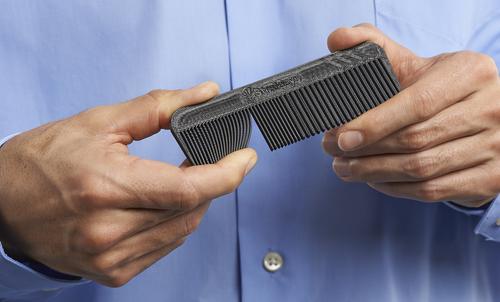Stratasys has introduced two 3D printing materials stronger than their predecessors: the second generation of digital ABS for Objet Connex multimaterial 3D printers and FDM Nylon 12, which is designed for the company's Fortus 3D Production Systems.
December 16, 2013
Stratasys has introduced two 3D printing materials stronger than their predecessors: the second generation of digital ABS for Objet Connex multimaterial 3D printers and FDM Nylon 12, which is designed for the company's Fortus 3D Production Systems.
Digital ABS and ABS2 are composite materials for Stratasys 3D printers that use its PolyJet process; they are made by simultaneously jetting two different plastics during build. This lets design engineers combine the colors, textures, densities, and mechanical properties of the polymers in a single object. These materials combine strength and stability with resistance to high temperatures. They are designed for making prototypes and models capable of sustaining high impacts. Digital ABS material can also be used to make cores and cavities for low-volume injection molding thermoplastic applications.
Click the image below to start our slideshow on the new materials.

The new Stratasys FDM Nylon 12 can be used to produce durable parts that can stand up
to repetitive stress, high vibration, or fatigue.
(Source: Stratasys)
Printing small parts, thin features, sharp edges, and thin walls requires polymers strong enough to withstand the stresses that occur during injection molding. This led to the development of Digital ABS2. Susan York, North American business manager for Stratasys' Materials Group, told us in an email that the first-generation Digital ABS has a core with higher temperature resistance (RGD535) and a tougher surface layer (RGD515). "In very thin walls the surface material RGD515 becomes more prevalent and hence more subject to flexibility."
That can be a good thing, but in certain applications, more rigid thin walls are needed. "With our second generation Digital ABS, our new software automatically identifies thin walls below 1.2 mm and applies a different composition of the two materials in order to obtain greater dimensional stability for all thin-walled features," York said. This will result in thinner-walled parts that maintain their shape better and are more dimensionally stable. Digital ABS2 is available in an ivory color, in addition to the original green. The ivory material is made from RGD531 with a new white component and RGD515, which offers the same toughness as the first-generation material.
Stratasys came up with its Fused Deposition Modeling (FDM) Nylon 12 so users could create unfilled nylon (polyamide) parts that are tougher and more flexible than is possible with other additive manufacturing technologies. Nylon 12 is one of the strongest engineering polymers available, so it's not surprising to read in a press release that the new material offers up to five times the resistance to breaking and better impact strength than the company's strongest FDM materials, such as ABS. Stratasys also says that, based on published specifications, its elongation-at-break specification is up to twice as high as other 3D-printed nylon 12 materials.
This impressed and intrigued me, especially for its potential in aerospace and automotive applications, so I asked York for more details. She said the elongation at break is 30%, compared with 14-15% published specs for competitors' Nylon 12 materials. Notched Izod impact tests showed the Stratasys material measures at 3.74 ft-lb/inch (200 J/m), compared to 0.6 ft-lb/inch (32 J/m) and 0.78 ft-lb/inch (40 J/m) for competitors. Unnotched Izod impact tests showed more than 37.4 ft-lb/inch (2,000 J/m), versus 6.3 ft-lb/inch (336 J/m) and 8.6 ft-lb/inch (460 J/m) for competitors. These characteristics imply that the new material may be used in parts that need high impact strength and fatigue endurance.
The new Nylon 12 material is available in black for the Fortus 360, 400, and 900 systems.
Related posts:
{doclink 269675}
{doclink 269539}
{doclink 269201}
{doclink 269091}
{doclink 268556}
{doclink 267987}
{doclink 267004}
{doclink 266774}
{doclink 266575}
{doclink 266382}
{doclink 266319}
{doclink 266147}
{doclink 265837}
{doclink 265793}
{doclink 265687}
{doclink 265139}
{doclink 265097}
{doclink 264842}
{doclink 264282}
{doclink 262621}
{doclink 262205}
{doclink 261369}
{doclink 260918}
{doclink 260118}
{doclink 259420}
{doclink 258906}
{doclink 258652}
{doclink 256862}
{doclink 256731}
{doclink 256092}
{doclink 255795}
{doclink 252293}
{doclink 251754}
{doclink 251513}
{doclink 250614}
{doclink 248401}
{doclink 248266}
{doclink 248157}
{doclink 247146}
{doclink 246025}
{doclink 238343}
{doclink 237571}
{doclink 236261}
About the Author(s)
You May Also Like



